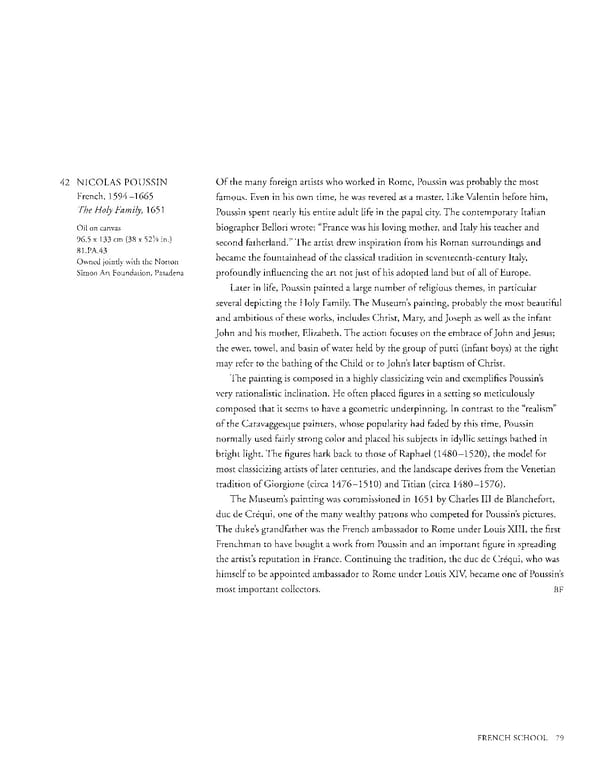42 NICOLAS POUSSIN Of the many foreign artists who worked in Rome, Poussin was probably the most French, 15941665 famous. Even in his own time, he was revered as a master. Like Valentin before him, The Holy Family, 1651 Poussin spent nearly his entire adult life in the papal city. The contemporary Italian Oil on canvas biographer Bellori wrote: "France was his loving mother, and Italy his teacher and 96.5 x 133 cm (38 x 52 in.) second fatherland." The artist drew inspiration from his Roman surroundings and 81.PA.43 Owned jointly with the Norton became the fountainhead of the classical tradition in seventeenthcentury Italy, Simon Art Foundation, Pasadena profoundly influencing the art not just of his adopted land but of all of Europe. Later in life, Poussin painted a large number of religious themes, in particular several depicting the Holy Family. The Museum's painting, probably the most beautiful and ambitious of these works, includes Christ, Mary, and Joseph as well as the infant John and his mother, Elizabeth. The action focuses on the embrace of John and Jesus; the ewer, towel, and basin of water held by the group of putti (infant boys) at the right may refer to the bathing of the Child or to John's later baptism of Christ. The painting is composed in a highly classicizing vein and exemplifies Poussin's very rationalistic inclination. He often placed figures in a setting so meticulously composed that it seems to have a geometric underpinning. In contrast to the "realism" of the Caravaggesque painters, whose popularity had faded by this time, Poussin normally used fairly strong color and placed his subjects in idyllic settings bathed in bright light. The figures hark back to those of Raphael (14801520), the model for most classicizing artists of later centuries, and the landscape derives from the Venetian tradition of Giorgione (circa 1476—1510) and Titian (circa 1480—1576). The Museum's painting was commissioned in 1651 by Charles III de Blanchefort, due de Crequi, one of the many wealthy patrons who competed for Poussin's pictures. The duke's grandfather was the French ambassador to Rome under Louis XIII, the first Frenchman to have bought a work from Poussin and an important figure in spreading the artist's reputation in France. Continuing the tradition, the duc de Crequi, who was himself to be appointed ambassador to Rome under Louis XIV, became one of Poussin's most important collectors. BF FRENCH SCHOOL 79
 Masterpieces of the Getty Museum: Paintings Page 79 Page 81
Masterpieces of the Getty Museum: Paintings Page 79 Page 81